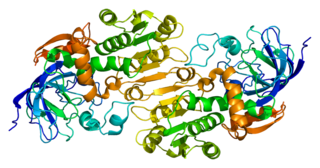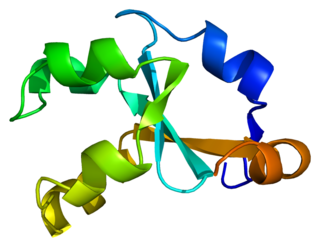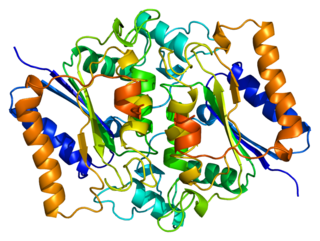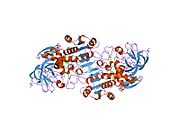
Alcohol dehydrogenases (ADH) (EC 1.1.1.1) are a group of dehydrogenase enzymes that occur in many organisms and facilitate the interconversion between alcohols and aldehydes or ketones with the reduction of nicotinamide adenine dinucleotide (NAD+) to NADH. In humans and many other animals, they serve to break down alcohols that are otherwise toxic, and they also participate in the generation of useful aldehyde, ketone, or alcohol groups during the biosynthesis of various metabolites. In yeast, plants, and many bacteria, some alcohol dehydrogenases catalyze the opposite reaction as part of fermentation to ensure a constant supply of NAD+.

Aldolase A, also known as fructose-bisphosphate aldolase, is an enzyme that in humans is encoded by the ALDOA gene on chromosome 16.
In enzymology, a S-(hydroxymethyl)glutathione dehydrogenase (EC 1.1.1.284) is an enzyme that catalyzes the chemical reaction

Glutathione S-transferase A1 is an enzyme that in humans is encoded by the GSTA1 gene.

Alcohol dehydrogenase 1C is an enzyme that in humans is encoded by the ADH1C gene.

Cytochrome b5, form A, is a human microsomal cytochrome b5.

Peroxiredoxin-2 is a protein that in humans is encoded by the PRDX2 gene.

Lipoamide acyltransferase component of branched-chain alpha-keto acid dehydrogenase complex, mitochondrial is an enzyme that in humans is encoded by the DBT gene.

Glutathione S-transferase A2 is an enzyme that in humans is encoded by the GSTA2 gene.

Thiosulfate sulfurtransferase is an enzyme that in humans is encoded by the TST gene.

NAD(P)H dehydrogenase, quinone 2, also known as QR2, is a protein that in humans is encoded by the NQO2 gene. It is a phase II detoxification enzyme which can carry out two or four electron reductions of quinones. Its mechanism of reduction is through a ping-pong mechanism involving its FAD cofactor. Initially in a reductive phase NQO2 binds to reduced dihydronicotinamide riboside (NRH) electron donor, and mediates a hydride transfer from NRH to FAD. Then, in an oxidative phase, NQO2 binds to its quinone substrate and reduces the quinone to a dihydroquinone. Besides the two catalytic FAD, NQO2 also has two zinc ions. It is not clear whether the metal has a catalytic role. NQO2 is a paralog of NQO1.

Protein-L-isoaspartate(D-aspartate) O-methyltransferase is an enzyme that in humans is encoded by the PCMT1 gene.

Concentrative nucleoside transporter 2 (CNT2) is a protein that in humans is encoded by the SLC28A2 gene.

Alcohol dehydrogenase 1A is an enzyme that in humans is encoded by the ADH1A gene.

Chymotrypsin-like elastase family member 3B also known as elastase-3B, protease E, or fecal elastase is an enzyme that in humans is encoded by the CELA3B gene.

Arylacetamide deacetylase is an enzyme that in humans is encoded by the AADAC gene.

Pregnancy-specific beta-1-glycoprotein 6 is a protein that in humans is encoded by the PSG6 gene.

D-beta-hydroxybutyrate dehydrogenase, mitochondrial is an enzyme that in humans is encoded by the BDH1 gene.

High affinity cAMP-specific and IBMX-insensitive 3',5'-cyclic phosphodiesterase 8B is an enzyme that in humans is encoded by the PDE8B gene.

Alcohol dehydrogenase 6 is an enzyme that in humans is encoded by the ADH6 gene.






























